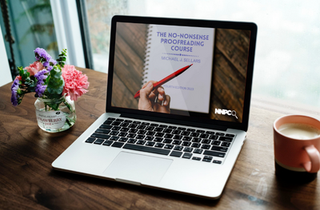What is Proofreading? Part Three: Errors.
What kind of errors? Generally, you’ll be looking for spelling mistakes and grammatical slip-ups. However, your remit is likely to change from one employer to another. When some organisations hire a proofreader, they expect something more in the way of a copy editor. In other words, they want your input on the quality of the document not just the accuracy. You’ll be looking for inconsistencies, awkward phrasing, lack of clarity. You might also be expected to ‘do the math’. If your employer produces ecommerce website or a sales brochure, you’ll be expected to make sure everything adds up, particularly when it comes to those all-important prices.
What is Proofreading? Part Four: Highlights.
How exactly, does a proofreader highlight errors? Directly onto the document with your trusty red pen. You’ll want something fine that doesn’t ‘bleed’ on paper. Clarity is everything.
You will circle or underscore the copy containing the error, then place a corresponding proofreaders’ mark in the margin.
You will circle or underscore the copy containing the error, then place a corresponding proofreaders’ mark in the margin.
What is Proofreading? Part Five: Proofreaders' Marks.
Proofreaders’ marks are the little symbols proofreaders use to indicate a particular kind of error. For example, when the symbol below is placed in a document’s margin, it tells someone to italicise any words or letters that are underlined in the copy adjacent to the proofreading symbol.
It takes a while to become familiar with proofreaders’ marks but they really are essential, as they enable you to communicate a great deal very quickly and without using up too much space. If you were to attempt to write out everything in full, you’d soon find your document reduced to an illegible mess.
What is Proofreading? Part Six: Originator.
So, who will be producing the work I’ll be proofreading. By and large, it is likely to be a typesetter or graphic designer. Once you’ve marked-up your proof (and old-fashioned name for a pre-press document), you will either hand it back to its originator or pass it on to the next person in the production process.
What is Proofreading? Part Seven: Subsequent Drafts.
This is where the hard work begins. ‘First reads’ as they’re often called can be relatively painless, as you’re reading from a clean document. Once your corrections have been carried out, you’ll have to check a new proof to make sure they’ve been carried out correctly and in their entirety. This is the main point at which errors creep into a document. Often your corrections will have been overlooked or new mistakes may have been created whilst carrying out your instruction (for example, an ugly line break may occur or text may ‘drop off’ the bottom of a page). This is where you will have to have your wits about you, as you comb through your original marked-up proof, ticking off each correction only when you have confirmed that it has been carried out to your satisfaction.
I hope that answers your question, what is proofreading?
The No-Nonsense Proofreading Course is a downloadable eBook containing a wealth of information to help you learn to proofread and take the first steps to becoming a professional proofreader.
It gives a full set of proofreading symbols, complete with instructions on how to use them; it offers a robust and thorough proofreading methodology; and it holds your hand as it walks you through the veritable minefield that is the ‘subsequent drafts’ stage of the proofreading process.
Best of luck with all your proofreading endeavours.
I hope that answers your question, what is proofreading?
The No-Nonsense Proofreading Course is a downloadable eBook containing a wealth of information to help you learn to proofread and take the first steps to becoming a professional proofreader.
It gives a full set of proofreading symbols, complete with instructions on how to use them; it offers a robust and thorough proofreading methodology; and it holds your hand as it walks you through the veritable minefield that is the ‘subsequent drafts’ stage of the proofreading process.
Best of luck with all your proofreading endeavours.
The No-Nonsense Proofreading Course
A Fraction of the Cost of Other Proofreading Courses
NOTE: Stock is currently limited to 10 per day, so we can continue to deliver exceptional after-sales service, answer queries and provide open-door support.
- Learn to proofread like a professional
- 30 years of experience distilled into a single easy-to-follow package
- Over 1,000 pages of FREE bonus eBooks and learning materials
- 30-day money-back 100% satisfaction guarantee
- Follow my advice and you will earn your money back in just two hours!
- Download it now and start learning and earning right away.
- I operate a virtual 'open door' policy after purchase, generally answering any and all email queries and concerns within 48 hours and usually sooner.
Credit card and PayPal payments accepted.
“As someone who has been proofreading for 30 years, I found Mike’s course an invaluable introduction and a very useful practical guide to many aspects of the discipline. I can wholeheartedly recommend it.” Jeremy Meehan, Proofreader.
Still want to find out more? Click here.


